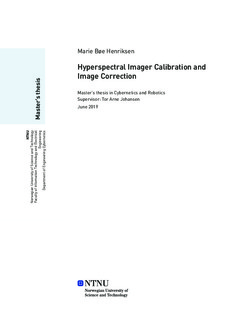| dc.contributor.advisor | Johansen, Tor Arne | |
| dc.contributor.advisor | Sigernes, Fred | |
| dc.contributor.advisor | Garrett, Joseph Landon | |
| dc.contributor.author | Henriksen, Marie Bøe | |
| dc.date.accessioned | 2019-10-31T15:12:18Z | |
| dc.date.issued | 2019 | |
| dc.identifier | no.ntnu:inspera:35771502:17931287 | |
| dc.identifier.uri | http://hdl.handle.net/11250/2625737 | |
| dc.description.abstract | Hyperspektrale kameraer, ombord blant annet droner og småsatellitter, skal detektere algeoppblomstring og andre havfenomener langs norskekysten. Dette er en del av prosjektet HYPSO, som står for "hyperspektral småsatellitt for havobservasjon". For at bildene skal være brukbare må kameraene være kalibrert og karakterisert før bruk. Det første målet i denne oppgaven var derfor å sette opp prosedyrer for spektral og radiometrisk kalibrering, og deretter kalibrere to hyperspektrale kameraer. Det andre målet var å detektere kjente feileffekter kalt "smile" og "keystone", samt korrigere for disse. Prosedyrer for spektral og radiometrisk kalibrering ble utviklet, og de hyperspektrale kameraene HSI V4 og HSI V6 ble kalibrert. Etter spektral kalibrering ble spektral rekkevidde regnet ut, og estimert til 299 til 1015 nm for HSI V4, og 378 til 851 nm for HSI V6. Videre ble et oppsett for å detektere "smile" og "keystone" utviklet, bestående av en kollimator, et stripete mønster og spektrale lyskilder. Effektene ble detektert ved å bruke skjæringspunktene dannet i spektrogrammet og videre korrigert for ved å transformere skjæringspunktene over på et referansegitter. Korreksjon av bilder fra HSI V4 viste en klar forbedring, men feilmodellen kan bedres. I tillegg ble spektral båndpass og lineæritet av sensorresponsen karakterisert. Spektral båndpass for HSI V4 ble estimert til 2.66 nm, og 2.84 nm for HSI V6. Resultatene viser at HSI V4 har tilnærmet lik lineær sensorrespons. | |
| dc.description.abstract | Algal blooms and other oceanographic phenomena will be detected by hyperspectral imagers from air- and spaceborne platforms, among others, as a part of the Hyperspectral Smallsat for Ocean Observation (HYPSO) mission. For the collected data to be usable, the hyperspectral instruments must be calibrated and characterised before use. The first goal of this project was therefore to set up calibration procedures for spectral and radiometric calibration of the Hyperspectral Imagers (HSIs), and further test these procedures by calibrating two imagers. The second goal was to detect spectral and spatial misregistrations in the system, also known as smile and keystone, and make corrections for these effects. Spectral and radiometric calibration procedures were set up, and two imagers, the HSI V4 and the HSI V6, were calibrated. After spectral calibration, the spectral range was calculated, and was found to be 299 to 1015 nm for the HSI V4, and 378 to 851 nm for the HSI V6. Further, a set-up to detect smile and keystone effects was designed and built, consisting of a collimator lens, a striped pattern, and spectral light sources. Algorithms were developed to detect the effects by using the resulting intersection points in the spectrogram. Corrections were then made by mapping the detected points to a reference grid. While correction of HSI V4 spectrograms showed clear improvement, the algorithms used to obtain the distortion model can be further improved to achieve even better performance. Other effects characterised include the spectral bandpass of the imagers, and the linearity of the sensor response. Spectral bandpass for the HSI V4 was estimated to be 2.66 nm, and 2.84 nm for the HSI V6. The sensor response of the HSI V4 was found to be linear. | |
| dc.language | eng | |
| dc.publisher | NTNU | |
| dc.title | Hyperspectral Imager Calibration and Image Correction | |
| dc.type | Master thesis | |
